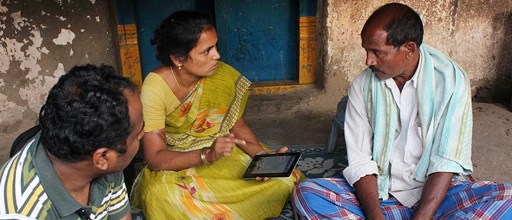This website uses cookies so that we can provide you with the best user experience possible. Cookie information is stored in your browser and performs functions such as recognising you when you return to our website and helping our team to understand which sections of the website you find most interesting and useful.
19 Feb 2014

Can South Africans tackle heart disease with the help of an egg cup and a Android phone? In their talk at the Martin School on Feb 6, Dr Fred Hersch and Professor Gari Clifford answered with a qualified, but hopeful, “yes.”
Dumb sensors, smart phones
Hersch and Clifford’s work focuses on non-communicable diseases (NCDs) in low- and middle-income countries. The World Health Organization (WHO) defines NCDs as diseases that are “not passed from person to person,” such as heart disease, cancer, respiratory illnesses, and diabetes. A paucity of doctors and under-resourced health systems mean that in low- and middle-income countries, NDCs often go undiagnosed. As a result, 90% of people who die of these illnesses before the age of 60 are from these parts of the world.
To tackle these and other health problems in low- and middle-income countries, researchers are experimenting with “mHealth,” using mobile technologies in health care. One way forward is to combine “dumb sensors,” like microphones and pressure gauges, with powerful and increasingly inexpensive smart phones. In the example pictured above, a microphone is glued into a metal egg cup, creating a low-cost stethoscope. A program on the phone analyzes the audio signal, calculating the patient’s heart rate. Eventually, researchers hope that the tool will also be able to detect abnormalities that might warrant a trip to the clinic.
Providing SMART health care in rural India

The goal is to put simple, inexpensive diagnostic tools into the hands of patients and community health-care workers. In India, the Ministry of Health & Family Welfare trains Accredited Social Health Activists (ASHAs) to provide basic care in communities where doctors and nurses are scarce. Hersch and Clifford are piloting a diagnostic tool called SMART Health to make it easier for ASHAs to identify people at risk for cardio-vascular diseases. Through a simple interface on an Android device, the software prompts the ASHA to ask the patient questions based on WHO guidelines. The program analyzes the responses, and if the patient is high-risk, the ASHA can provide more information and refer them to a doctor.
Avoiding failure
Initiatives that try to address big challenges using tidy technological solutions don’t always work. A technology that is parachuted into a community without full awareness of the local context may be difficult for the intended recipients to use, may be rejected because it contravenes local customs or norms, or may simply not function in the physical environment. SMART Health takes this into account. Hersch stresses the importance of viewing a new technology not as a stand-alone solution, but as part of a broader context that includes the day-to-day systems and human use patterns that are already in place. The tool is being developed collaboratively with patients, ASHAs, and doctors, and it is being piloted in the communities it is intended for.
Another risk with technological solutions is that existing inequalities might be worsened. This happens if the people who are best able to access the technology and its benefits are those who are already privileged in some way, for example by being relatively well-off, or by having ties with powerful local actors. Problems such as health care provision are often entwined with culture and politics; well-intentioned outsiders may not be positioned to grapple with or even fully understand these issues. In the case of SMART Health, working through the intermediary of the ASHAs means that the tool will be available to anyone that the ASHAs serve, regardless of the patients’ access to technology more generally. This does not preclude the possibility that ASHAs themselves are more accessibly to certain groups within the community, and if this is the case, those already-privileged groups will indeed have better access to the benefits of the technology.
Overall, the approach the SMART Health team is taking demonstrates an awareness of the technical and political issues around developing new technologies for use in low- and middle-income countries.
This piece appears in full on the author’s personal blog.
